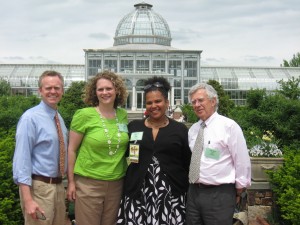No Child Left Inside: Restoring Nature to Early Childhood Symposium — From Fairies to Frogs!
My teacher husband wrote a great blog post on the Garden’s recent Dinner in the Garden for Teachers that Lewis Ginter hosted as part of our No Child Left Inside: Restoring Nature to Early Childhood symposium, so, I’ll let you read about Jane Kirkland, our keynote speaker and her wonderfully funny and inspiring story on his blog.
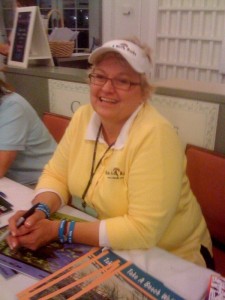
Jane Kirkland signs books at the No Child Left Inside symposium
I want to get down to business talking about some of the amazing speakers that inspired me the next day, during our full-day symposium. And also, some of the children that inspired me at the Homespun Fun for Families event that followed later that evening.
First, we were so fortunate to have Virginia’s First Lady, Anne Holton, provide welcoming remarks at the symposium. I couldn’t help but smile when she told the audience how she and Governor Tim Kaine used to come here to Lewis Ginter Botanical Garden in the Garden’s earliest days to have serious discussions. This is a wise woman who knows that nature allows us to step out of the box of life and nature somehow allows us to find solutions to our problems and conflicts that we might have otherwise overlooked.
Jane Kirkland, who had inspired us so wonderfully the night before at the Dinner in the Garden for Teachers, gave us some detailed ideas about how to incorporate nature into classrooms by making field guides with our children. Robin Moore, Director of the Natural Learning Initiative and Professor of Landscape Architecture, North Carolina State University, really opened my eyes to how much nature really affects children, with a simple view of trees having a measurable effect on attention functioning. Of course I knew about the relationship between lack of outdoor play and obesity and diabetes in children, but I had no idea that outdoor play could prevent myopia — or nearsightedness. Apparently, if you don’t use the vision to look off into the distance you can loose it! I also learned that you don’t need to spend a great deal of time outside reap the healthy benefits of nature. “The minimum daily dose is actually quite small,” Moore says.
Akiima Price, Chief of Education and Programs, New York Restoration Project, founded by Bette Midler, blew me away with her grounded and common sense approach to reaching out to urban youth. I felt double lucky that Akiima was such a brilliant and inspiring speaker because she was a last minute substitution for one of our speakers who couldn’t make it. Part of what was so special about Akiima was that she came from a background that didn’t focus on nature, but discovered it herself later in life in a program that reached out to women and minorities to explore the idea of a career in environmental education. Akiima saw firsthand the impact exposure to nature made in her own life and because of her background, she is able to help children who might have had little access to nature to enjoy it without being frightened by it.
She easily understands and reaches out to the children who come from urban and low income areas who might have very little experience with nature and helps educators reach out to them in ways that they can relate to. Basically, this is her genius.
“I evolved into an environmental education specialist because I realized my niche was working as a bridge between the people that have the information and the wonderful opportunities and the land and the programs, with the folks that they are trying to reach,” she says.
Akiima explained how in Las Vegas, where she was working, the environmental educators were reaching out to low income children in that area but were doing it indoors. She questioned, where no one else had before, “Why are we doing this indoors?” OK, it seems like the obvious solution looking back and knowing what we know now, but for the program at this Las Vegas nature center to change, it took Akiima to question — “As opposed to talking about a cactus as a picture, why not have them looking at a cactus in real life and actually have that [experience].”
Akiima’s program uses new ideas to bring entire families to the garden. Ideas anyone, even on a small budget here in Richmond could easily apply. Garden games, using giant dice with pictures on them, matching games using images of items from gardens, and the kids favorite — Go Dig, a version of Go Fish! She says she noticed that with many of the troubled children she worked with that they are able to forget about the problems they have for a while in her program either it is because they are playing garden games, or somehow immersed in nature holding a snake, planning a garden, planting seeds or having a sleepover in the garden. It offers them a place to be where they aren’t consumed by their troubles.
Much of her work, she explained, is achieved by asking simple questions that make the children think, “Where did this trash come from?” leads to an interesting discussion about combined sewage overflow. Another entire facet of her work was dedicated to building trust within the communities and with the children in particular. Building a trusting relationship with the children has staying power even outside of the garden that is something they can apply to life. Commitment ceremonies — to the garden are not uncommon and help children, in their own words, make a promise to fulfill a responsibility.
Another project educated the children about pollution and the affects that trees can have on reducing it. The project was simple enough — taking Popsicle sticks covered in Vaseline into high-traffic areas outside where they would be exposed to air and leaving them for a week. The children were completely floored when the contraptions filled with black particles.
Other ideas to get kids excited? A salsa garden, a pizza garden and, believe it or not – a compost toilet — which she said freaked the kids out at first, but then everyone wanted to use it.
Ashley and Chip Donahue, founders of Kids in the Valley, in Roanoke, made a huge impression on me. Not only have they single-handedly founded a huge club where kids and their families can take adventures in nature together, but with 3 kids themselves, they are walking the talk. They spoke about their many experiences of leading the KIVA trips, and one thing they mentioned is that they never cancel a trip due to the weather. They go rain or shine, and it adds another layer to the experience. Namely, I’m guessing the children learn they are tougher than they thought. Plus, Chip and Ashley said, once they get around their friends, they don’t complain like they do sometimes at home, or when it is just your family.
One thing that Chip said that really struck me is that sometimes it’s OK to let you children out of your sight. He talked about using a red backpack, centrally located, as a point that both the kids and the adults keep in sight and this method allowed his children to explore more independently and have more opportunities to use their problem- solving skills. For me this was a big deal, as I’ve always been one of those parents who won’t let their kids out of their site EVER. And with Chip and Ashley on site at the Garden on Wednesday night, I got to put it into practice — for the first time ever, I let my kids be in two separate areas of the Garden, each doing the thing they wanted to do. My son wanted to build his fairy house in the Children’s Garden mulberry tree and my daughter wanted to build hers down in the woodland point. Chip and Ashley addressed people’s fear directly. Why should I let my fear hinder my children’s experiences?
Tracy Kane, author of the Fairy House Series of books, did a great job working with the children to build elaborate fairy houses out of natural materials. The kids loved it when she brought out fairy food and water for the little creatures!
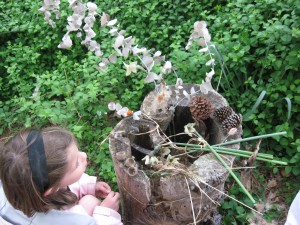
A fairy house at Woodland Pointe in the Children’s Garden
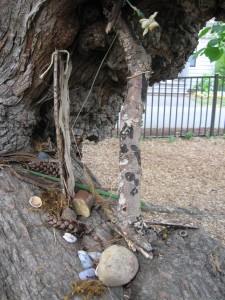
My son’s fairy house in the mulberry tree.
Since I started working here at Lewis Ginter Botanical Garden over 6 months ago, I’ve learned a lot about children and why they need nature. As I sat down to listen to the speakers for the Garden’s No Child Left Inside: Restoring Nature to Early Childhood symposium, last week, I wasn’t sure what more I’d learn, and what I’d take away from it. But, I have to say, I learned alot. In fact, not only have I learned a lot, but I’ve put it to good use — including setting an example for my kids. On Mother’s Day, for the first time ever, I caught a frog. And guess what? Two minutes later my daughter caught her first ever frog too. Speaking of fears, so far, no warts yet! Here are the pictures. What do you think?
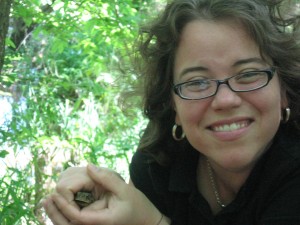
That is me holding my first frog!
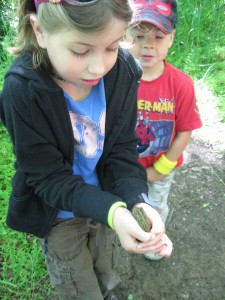
That is my daughter at the river holding her first frog, check out my son’s face!
